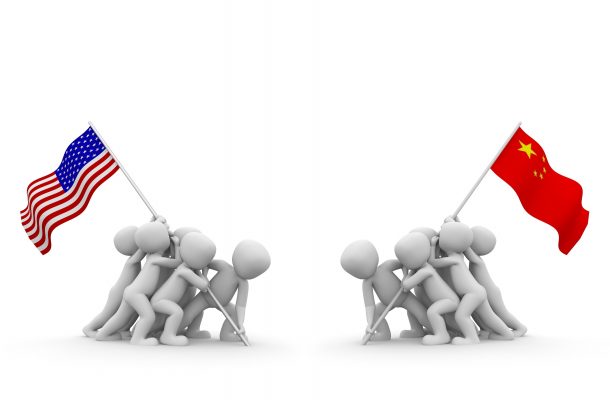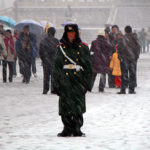Rethinking Australia’s relations with the USA and China

China’s burgeoning international presence and comfort with “wolf-warrior” diplomacy, coupled with an antagonistic U.S. under President Donald Trump has spelt trouble for Australia’s policy-makers.
Recent relations between the two superpowers have been characterised by economic competition, trade wars, sharp rhetoric and whispers of a battle over hegemony. The escalation of conflict has potentially disastrous implications for Australia and a strategic rethink is necessary to protect our national security, regional security, economic and ideological interests.
Effective management of Australia’s tenuous position between the two states demands an ability to reject binary thinking that might tilt Canberra’s decision-makers heavily one way or the other.
An analysis of how U.S.- China tensions threaten Australian interests and an evaluation of who is to blame for the capitulation of congeniality, provide useful context for the question of Canberra’s response. The most pragmatic solution could be a policy of strategic hedging, characterised by “a combination of engagement and indirect/ soft balancing” coupled with a dovish approach to the all-important Indo-Pacific.
This would entail a renewed commitment to diplomacy, aid and multilateral cooperation. Notably, Australia must give antagonism a wide birth, taking steps to diversify from both states whilst finding common ground where appropriate.
There is no doubt, as noted by Defence Minister, Linda Reynolds, that heightened Sino-American tensions spell the most critical period in international relations Australia has seen since WWII. Australia’s national security and economic, regional and ideological interests are very much on the line.
How do US-China tensions threaten Australia’s interests?
Australia has a strategically important relationship with the U.S, due to the historic ANZUS treaty. We also enjoy an economically significant relationship with China, our largest trading partner, which purchases over a third of Australian exports.
This delicate balance of strategic and trade interests, place us at the centre of an escalating competition between the U.S. and China, amounting to what Beeson & Bloomfield refer to as “the defining foreign and strategic policy challenges for Australian policymakers”.
The threat is heightened by the fact that Australia, due to geography, is precariously placed. Any military conflict is likely to occur in the Indo-Pacific, not far from our shores. Australia is important to the U.S.’s China strategy, as we are close enough to challenge China’s claims in the Western Pacific.
Australia has, in turn become of greater interest to China, who view us as a “force multiplier for the United States in the Western Pacific”, and have warned against taking sides as U.S.- China antagonism escalates.
The extent to which China values their relationship with Australia is certainly debatable. We are but a relatively microscopic dot on their balance sheet, which means that Australia’s leverage with China is likely insignificant as Australia needs China more than China needs Australia.
It is at this point unclear whether Australia will continue to enjoy the almost-anachronistic status quo, which promised military protection and “mateship” with the U.S. and deep economic engagement with China, a welcome effect of foreign policy characterised by accommodation.
What Australian interests are at greatest risk due to US-China tensions?
China is partial to conducting policy by way of economic statecraft, using industry to advance the CCP’s political agenda. Their willingness to impose tariffs on Australian exports such as wine, beef and barley amongst others, is a mere taste of what awaits should we continue to adopt a watered-down version of the U.S.’s China policy.
The U.S.- China trade war, whilst escalated by both parties, should offer further deterrence to Australia’s policymakers. If Canberra refuses to shift course, it is conceivable our economy could suffer under pointed attack. Wesley notes Australia and the U.S. could find themselves commercially and diplomatically locked out of Asia as it gravitates closer to China’s ideological centre.
Whilst China is unlikely to view their economic engagement with Australia as a vulnerability, the extent to which we are reliant on China to purchase exports places us in an extremely precarious position. The Morrison government is best advised to heed this fact before it’s too late.
In what can perhaps best be described as hysteria, Australia has been sucked into the vortex of hyper-securitization and militarization by the U.S, at the expense of more dovish means of statecraft. This functions to threaten our national security and regional interests, as over-securitizing runs the risk of escalating conflict.
He & Li argue the CCP view the U.S.’s Indo Pacific strategy as a direct act of containment, citing the risk of the ‘Thucydides Trap’ between the dominant power, the U.S. and the rising power, China.
Australia is implicated due to our military mateship with the U.S. This poses a grave threat to our national security as well as to the reginal security of the Indo-Pacific which, disconcertingly, happens to be on Australia’s doorstep.
The question of whether a hegemonic China could pose an ideological threat to liberal democracies is continually debated . Some claim China to be a revisionist state eager to change the global order and promote illiberalism, whilst others reject this fact entirely.
Despite these differences in opinion, and the risk of hystericizing the issue, it would be unwise to discount the threat of an ideological stand-off entirely. It is not a requirement for Australians to panic at the prospect of democracy being at siege at the behest of a “China Threat – the fear of being taken over by China and the Chinese”.
However, it is worth paying careful attention to how China’s rise to global superpower may imperil some liberal values, as well as existing norms of global governance and Australia’s standing in the global world order.
Who is to blame: the US or China?
The souring of Sino-American relations has been bolstered by acts of aggression on both sides. Pain points have arisen from China’s stealing of intellectual property, the imposition of tariffs, first introduced by the U.S., China’s wolf-warrior diplomacy and other provocative speech acts, such as Trump’s repeated referral to COVID-19 as the “China virus”.
It does not help that the U.S. has allowed itself to be lured into what is looking more and more like a Thucydides trap, with unquestionably injudicious rhetoric provoking the CCP and preventing the China challenge from being handled via quieter, and likely more effective means.
Can China be blamed for adopting a more ambitious, expansionist stance under Xi Jingping? The U.S. and Australia have certainly reaped the rewards of engagement with a more open China. It seems naïve to assume rising power would develop without rising ambition, particularly in the context of Trump’s abdication of American leadership in global governance, coupled with his attempt to bar China from engagement in the U.S. technology and innovation sectors.
Perhaps a new strategy is needed for cooperative engagement where commonalities exist and effective management where differences in values persist.
What should Australia do in response?
Whilst some believe China is unlikely to want to challenge America’s role as leader in matters of global governance, the threats the U.S.- China tension pose to the international order and some of the liberal values Australia holds dear should be taken seriously.
A strengthening of liberal and democratic values amongst neighbouring states is one way to balance against China’s “sphere of influence” and develop better relations with regional actors. Another way is to is to strengthen and institutionalise military alliances.
Brands & Edel note “strong security arrangements, backed by formidable U.S. military power, might harden feelings of antagonism and suspicion, but they are indispensable to preserving the peace”. This, in effect, highlights the issue with a militarised response.
To circumvent the very real prospect of being dragged into a security dilemma with the U.S, Australia must adopt a policy of “strategic hedging… a combination of engagement and indirect/ soft balancing”. Australia cannot match the military might of either China or the U.S, with our defence spending comparing pitifully to both states, thus a hedging strategy, coupled with continuing engagement in ‘The Quad’ is necessary.
The Quadrilateral arrangement provides incentive for America to remain an active presence in the Indo-Pacific, and allows Australia to diversify and strengthen military ties with other states, notably India, Japan and Indonesia, should the U.S. become a less salient figure in the region.
The strengthening of military ties should be done with utmost subtlety so as to avoid antagonising China, something that Australia is failing spectacularly with at present.
Whilst some degree of military deterrence is necessary, committing to more dovish means of statecraft, including diplomacy and aid is critical to an effective response. Investing in these areas is likely to create stronger linkages, both diplomatic and commercial between Australia and states in the Indo-Pacific region which will serve to balance against China, effectively increasing Australia’s influence.
It would be a mistake neglect diplomacy in our response, as it could offer an opportunity for Australia to take on a regional leadership role, additionally providing an opportunity for us to step out from the shadows of the U.S, signalling peace with China.
What should Australia’s policy toward the US and toward China look like?
With respect to our China posture, we should seek to diversify economically, without pulling out of the country entirely. This would be unwise as it would likely provoke the CCP and additionally lock us out of an enormous amount of economic opportunity.
China is, after all, set to overtake the U.S. as the most significant driver of the global economy. Identifying new trade opportunities with India, the world’s largest democracy, could work to diversify and strengthen our trade portfolio.
More broadly, the Australian Government should use COVID-19 as an opportunity to reset our relationship with China and to extricate ourselves from the U.S.’s shadow, giving antagonism a wide birth.
In doing so we should seek to find common ground with China where possible, possibly through multilateral development in the Indo-Pacific, perhaps by reemphasising the role of ASEAN , or by developing a new multilateral framework within which the ‘Indo-Pacific’ concept can be institutionalised. This would encourage cooperation rather than conflict between regional actors.
Domestically, Australia should emphasize the importance of China to the solving of collective action challenges such as the climate crisis, highlighting the progressive steps China has taken toward the Paris targets, in an attempt to shift unhelpfully hostile public perception.
Additionally, Australia should remain neutral in the absence of acts of unreasonable aggression in the context of China’s territorial disputes so as to protect our national interests, warding against threat by maintaining conciliatory relations with China.
Former Australian Ambassador to China, Geoff Raby notes an inability to do so would likely result in a tarnishing of Australia’s posture amongst regional powers, this theory is also supported by Hugh White of ANU.
When respect to our U.S. posture, Australia must step out from the shadows and cast itself in an independent light, avoiding getting drawn into a conflict with China. As stated, it is in Australia’s interests to participate in The Quadrilateral arrangement, in part for its proclivity to keep the U.S. in the Indo-Pacific.
Despite this, we must be seen to have an independent voice from that of the U.S, remaining cooperative, but signalling to China that we are not their lapdog, that our foreign policy is not an extension of theirs. This is particularly significant with respect to matters of trade, due to our economic compatibility with and reliance on China.
The economic stakes are simply too high for us to blindly follow the U.S. into battle. A hedging strategy, diversification from economic reliance on China and military reliance on the U.S, coupled with a renewed commitment to diplomacy and aid in the Indo-Pacific are antidotes to the numerous threats deteriorating U.S. – China relations pose to our national security, regional security, and economic and ideological interests.
Sophie Mayo is studying a Masters of International Relations at The University of Sydney. She is passionate about Australian foreign policy and is currently interning at Global Access Partners.













